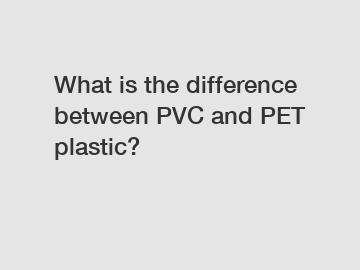What is the difference between PVC and PET plastic?
What is the difference between PVC and PET plastic?
Plastic is an essential material in our modern world, but not all plastics are created equal. Two commonly used types of plastic are PVC (Polyvinyl chloride) and PET (Polyethylene terephthalate). Although they might seem similar at first glance, there are several important differences between them. Let's dive deeper into this topic and explore their dissimilarities.
1. Chemical Composition:

- PVC: Polyvinyl chloride is a type of plastic made from vinyl chloride monomers. It is a thermoplastic polymer that is chemically synthesized from petroleum or natural gas.
- PET: Polyethylene terephthalate, on the other hand, is made from ethylene glycol and terephthalic acid. It is also a thermoplastic polymer and is derived from petroleum-based raw materials.
2. Physical Properties:
- PVC: PVC is a rigid plastic known for its high durability and versatility. It is often used in building materials, pipes, and window frames due to its excellent strength and resistance to impact. However, it can become brittle over time and may release toxic gases when burned.
- PET: PET is a transparent and lightweight plastic. It has exceptional clarity, making it suitable for applications like food packaging and beverage bottles. PET is also resistant to impact and provides good barrier properties against moisture and gas. Additionally, it is highly recyclable.
3. Environmental Impact:
- PVC: While PVC offers many benefits, it poses greater environmental concerns compared to PET. The production of PVC requires the use of harmful chemicals such as chlorine and dioxins, which can have adverse effects on human health and the environment. Moreover, PVC takes a long time to degrade in landfills, further contributing to pollution.
- PET: PET is considered to be more environmentally friendly than PVC. It is widely accepted for recycling, and many products made from PET can be transformed into new items, reducing waste and conserving resources. Despite this, improper disposal of PET bottles remains a significant issue, as they can take hundreds of years to decompose in the environment.
4. Applications:
- PVC: PVC's durability and versatility make it suitable for various applications. It is commonly used in construction, electrical cables, healthcare products like IV bags, and vinyl records. However, its environmental concerns and potential health risks in certain applications have led to a shift towards more sustainable alternatives.
- PET: PET's transparency and excellent barrier properties have made it the preferred choice for packaging materials. It is widely used for beverage bottles, food containers, and polyester fibers for textiles. PET's popularity has grown due to its recyclability and the increased demand for sustainable packaging solutions.
In conclusion, PVC and PET are two distinct types of plastic with significant differences. While PVC offers durability and versatility, it also comes with environmental and health concerns. PET, on the other hand, is transparent, lightweight, and easily recyclable, making it a more environmentally friendly option. When it comes to choosing between the two, considering factors such as application requirements, environmental impact, and recyclability is essential. As consumers, it's important to be mindful of our plastic consumption and opt for sustainable alternatives whenever possible.
For more information, please visit rPET pellets, rPET pellets, rPET pellets.

Comments